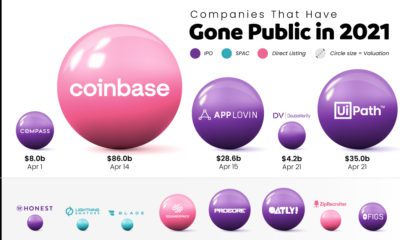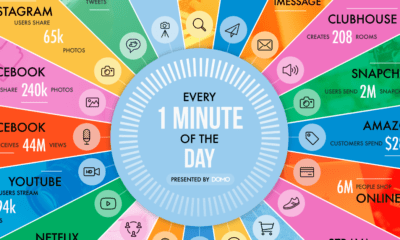Ultimately it all boils down to one simple principle: you must have a product that solves a pressing problem, and then the right amount of paying customers to make the math work.
Going Hunting
Today’s infographic comes to us from Point Nine Capital, and it highlights five basic revenue models that startups can use to achieve $100 million in annual revenue. The take home message here is that to build a long-term business, a team must implement a realistic strategy that considers multiple factors including product-market fit, user acquisition, pricing, and revenue per user.
Are you hunting flies, or are you trying to hunt elephants? Just like in real life, these things require very different strategies and tactics. To build a $100 million revenue per year company, you’ll need to have a clear vision of your product-market fit and the customers you’re going after.
Different Tools
While the hunting analogy may be an oversimplification, it does help illustrate an undeniable truth to building large companies: how many users you will need depends on how much revenue you can earn per user. This has implications. If you are going to get $10 in annual ad revenue for each user, then you need a lot of users. If you’re going after Fortune 500 companies, you’ll need far fewer customers, but also a sophisticated and detailed sales strategy. Flies – $10 per user x 10 million customers = $100 million in annual revenue It takes a lot of flies to add up. To build a big business with flies, you’ll need a product with a high viral coefficient (Instagram, WhatsApp, etc.) that spreads your brand quickly and inexpensively. Alternatively, you can build a platform that allows for the creation of massive amounts of user generated content (UGC) such as Yelp or Reddit. Mice – $100 per user x 1 million customers = $100 million in annual revenue Mice are still pretty small, but the expectations are higher than for flies. To get $100 per user, these customers will have to be directly paying for something, like a $10 monthly subscription. Music-streaming company Spotify is a good example of a startup hunting for mice. Rabbits – $1k per user x 100k customers = $100 million in annual revenue Once you hit rabbit territory, we are basically out of reach of B2C customers. That means to get 100k customers, they will likely have to be small businesses. To do this, you’ll need a fantastic product, excellent inbound marketing, and an extremely high NPS (Net Promoter Score). The latter metric is used to measure the likelihood a customer would recommend you to their peers. Deer – $10k per user x 10k customers = $100 million in annual revenue We’re now getting up there in size – which makes it likely that deer have to be medium-sized businesses. These customers can afford to spend $10,000 per year, but expect a significant return on their investment. While revenue per user is much higher than preceding levels, it is still not likely enough to warrant traditional enterprise field sales. Elephants – $100k per user x 1k customers = $100 million in annual revenue Going after elephants is a totally different world, and requires a skilled sales force, patience, and an enterprise-focused approach. You’ll need to educate Fortune 500 companies on why they should spend $100,000 with you each year – and you’ll need to be able to back that all up with a killer product. Software as a Service (SaaS) companies like Workday or Salesforce often use this kind of strategy, and it allows them to key in on the features that their most important clients want to see. As we noted in a previous infographic, investors love the predictable revenue stemming from a well-positioned SaaS company.
on But fast forward to the end of last week, and SVB was shuttered by regulators after a panic-induced bank run. So, how exactly did this happen? We dig in below.
Road to a Bank Run
SVB and its customers generally thrived during the low interest rate era, but as rates rose, SVB found itself more exposed to risk than a typical bank. Even so, at the end of 2022, the bank’s balance sheet showed no cause for alarm.
As well, the bank was viewed positively in a number of places. Most Wall Street analyst ratings were overwhelmingly positive on the bank’s stock, and Forbes had just added the bank to its Financial All-Stars list. Outward signs of trouble emerged on Wednesday, March 8th, when SVB surprised investors with news that the bank needed to raise more than $2 billion to shore up its balance sheet. The reaction from prominent venture capitalists was not positive, with Coatue Management, Union Square Ventures, and Peter Thiel’s Founders Fund moving to limit exposure to the 40-year-old bank. The influence of these firms is believed to have added fuel to the fire, and a bank run ensued. Also influencing decision making was the fact that SVB had the highest percentage of uninsured domestic deposits of all big banks. These totaled nearly $152 billion, or about 97% of all deposits. By the end of the day, customers had tried to withdraw $42 billion in deposits.
What Triggered the SVB Collapse?
While the collapse of SVB took place over the course of 44 hours, its roots trace back to the early pandemic years. In 2021, U.S. venture capital-backed companies raised a record $330 billion—double the amount seen in 2020. At the time, interest rates were at rock-bottom levels to help buoy the economy. Matt Levine sums up the situation well: “When interest rates are low everywhere, a dollar in 20 years is about as good as a dollar today, so a startup whose business model is “we will lose money for a decade building artificial intelligence, and then rake in lots of money in the far future” sounds pretty good. When interest rates are higher, a dollar today is better than a dollar tomorrow, so investors want cash flows. When interest rates were low for a long time, and suddenly become high, all the money that was rushing to your customers is suddenly cut off.” Source: Pitchbook Why is this important? During this time, SVB received billions of dollars from these venture-backed clients. In one year alone, their deposits increased 100%. They took these funds and invested them in longer-term bonds. As a result, this created a dangerous trap as the company expected rates would remain low. During this time, SVB invested in bonds at the top of the market. As interest rates rose higher and bond prices declined, SVB started taking major losses on their long-term bond holdings.
Losses Fueling a Liquidity Crunch
When SVB reported its fourth quarter results in early 2023, Moody’s Investor Service, a credit rating agency took notice. In early March, it said that SVB was at high risk for a downgrade due to its significant unrealized losses. In response, SVB looked to sell $2 billion of its investments at a loss to help boost liquidity for its struggling balance sheet. Soon, more hedge funds and venture investors realized SVB could be on thin ice. Depositors withdrew funds in droves, spurring a liquidity squeeze and prompting California regulators and the FDIC to step in and shut down the bank.
What Happens Now?
While much of SVB’s activity was focused on the tech sector, the bank’s shocking collapse has rattled a financial sector that is already on edge.
The four biggest U.S. banks lost a combined $52 billion the day before the SVB collapse. On Friday, other banking stocks saw double-digit drops, including Signature Bank (-23%), First Republic (-15%), and Silvergate Capital (-11%).
Source: Morningstar Direct. *Represents March 9 data, trading halted on March 10.
When the dust settles, it’s hard to predict the ripple effects that will emerge from this dramatic event. For investors, the Secretary of the Treasury Janet Yellen announced confidence in the banking system remaining resilient, noting that regulators have the proper tools in response to the issue.
But others have seen trouble brewing as far back as 2020 (or earlier) when commercial banking assets were skyrocketing and banks were buying bonds when rates were low.














